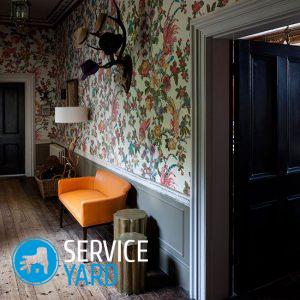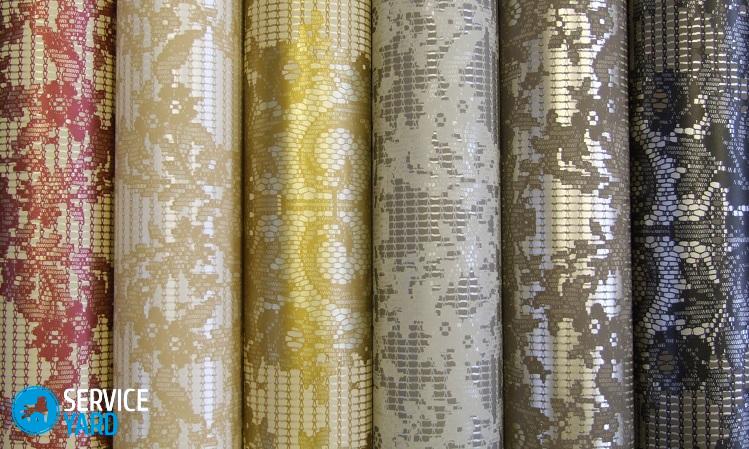Is it possible to glue wallpaper on painted walls?

Wallpaper is the simplest and most convenient material for decoration, and in most cases it is affordable. Often, when preparing a room for wallpapering, a fairly fair question arises: is it possible to glue wallpaper on painted walls? In this article, we will tell you that this procedure is not carried out in all cases. The gluing of painted rooms depends on the type of paint applied to the surface.
to contents ↑The risks of wallpapering on paint
If the room is finished with oil paint, it is recommended to remove it. The material is able to exfoliate, while it is difficult to provide the necessary adhesion of the adhesive.
Important! Having glued the canvas on such a finish, it is likely that it will disappear along with a layer of paint material.
It is also undesirable to paste over a room with applied water-based paint. This coating does not tolerate moisture. When processing the finishing material with adhesive, the coating may swell and peel off.
Important! It is best to glue wallpaper on a water-dispersion type paint, for example, acrylic refers to such. It is well applied, perfectly adheres, not afraid of moisture.
How to find out what composition the room was painted?
Before you paste the wallpaper on the painted walls, it is worthwhile to find out the type of paint that was previously used to decorate the room. Of course, when painting a room earlier in person, you can remember exactly which composition was used. But in cases where even the master is unknown, you still need to find out the type of composition used.
There is a proven way to identify the applied coating. To do this, take a damp rag, make several movements on the wall and evaluate the consequences:
- The appearance of foam on the surface and traces of decoration on the fabric indicate the use of a water-based emulsion type for staining. You can wash it off with clean, warm water.
- In the absence of the above traces of moisture on the material, you can slightly pry the finish with a spatula. If it leaves in pieces, it means - an oil coating was used.
- In the case of good adhesion of the material to the wall, it can be concluded that the composition of the water-dispersion type was used.
Checking adhesion of old material
After the completed manipulations, it is necessary to understand how firmly the old coating adheres to the surface, is it possible to glue wallpaper on painted walls?
To do this, stick construction tape on the finish and sharply pull it in the opposite direction. If there are cladding particles on the adhesive tape, the coating should be removed. If the finish has passed the test, then you can proceed to further preparatory work, without removing the finish.
Important! If the walls are affected by mold or fungus, then they cannot be pasted. In this case, the old coating must be removed, and the cleaned surface must be treated with an antifungal solution.
How to remove a bad finish?
There are several ways to remove old trim:
- The coating can be thoroughly soaked with water, and then remove the finishing material with a spatula, while not forgetting to constantly moisten the surface.
- Wet the walls with water, and then use old glue to apply old newspapers to the surface. After drying, tear off the newspapers with a layer of cladding.
- The use of special solutions from construction stores will help to destroy the structure of the finishing material, after which the coating is removed without any problems.
- To remove the finishing layer, a grinding machine or sandpaper will help. However, the implementation of this method will take a lot of time and effort.
Oil paint
Wallpapering on oil-painted walls is possible only with good adhesion of the finish to the surface. In any case, before you begin, you need to know how to process a painted wall before wallpapering.
To prepare the old coating:
- Sand the surface to a matte finish to improve adhesion.
- Remove dust from the walls by rinsing them thoroughly and then drying them.
- Treat the surface with a special primer using a paint roller.
- After drying, apply a second coat of primer.
to contents ↑Important! Only after the work done can you start gluing wallpaper on the painted walls. And in order to keep them better, experts advise adding PVA in wallpaper glue in proportions of 2: 1.
Waterborne Acrylic Paints
To glue a room with applied water-dispersed acrylic paint, you must perform the following steps:
- Wash the finishing material from dust and wait for it to dry.
- Primer in 2 layers.
Important! Do not forget that the second layer can be applied only after complete drying of the first.
- Coat the walls with highly diluted glue.
- After waiting for the complete drying of the working surface, you can proceed to gluing.
Water-based paint
How to glue wallpaper on painted walls with a water-based composition? The principle of operation is the same - first you need to check the condition of the old coating. If the material holds well and does not exfoliate, you need to treat it with a primer 2 times, while carefully drying each of the layers. Full drying can be expected somewhere after a day. Then proceed to gluing the room.
to contents ↑Important! In case of peeling of old paint, it must be removed without fail. This can be done using the methods already described above.
Stock footage
Sticking wallpaper on a painted surface will significantly reduce the time of preparatory work and speed up the entire repair as a whole. It is only necessary to approach the process as responsibly as possible, carefully preparing the room. Only then can you get an excellent result.
- How to choose a vacuum cleaner taking into account the characteristics of the house and coatings?
- What to look for when choosing a water delivery
- How to quickly create comfort at home - tips for housewives
- How to choose the perfect TV - useful tips
- What to look for when choosing blinds
- What should be running shoes?
- What useful things can you buy in a hardware store
- Iphone 11 pro max review
- Than iPhone is better than Android smartphones




